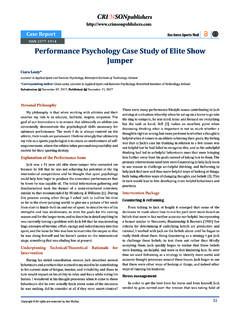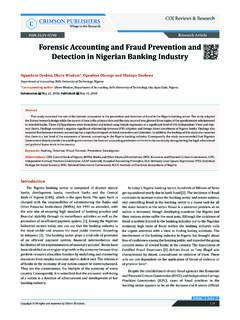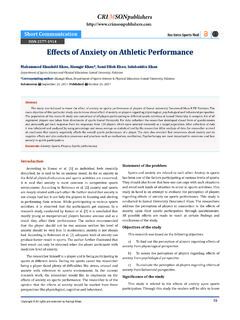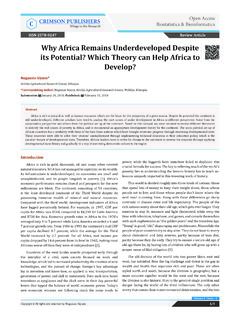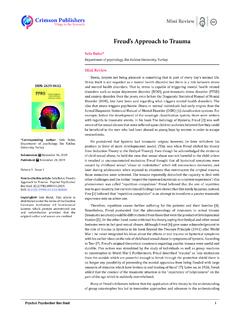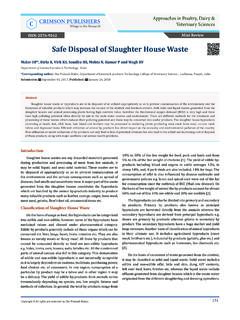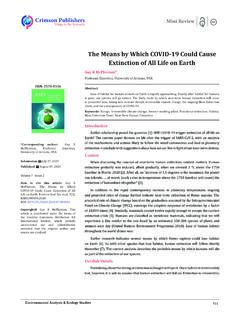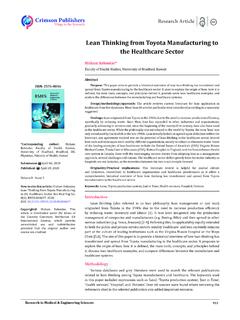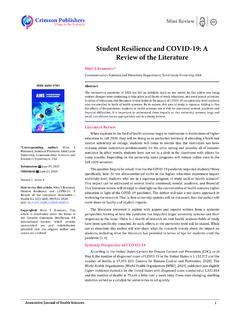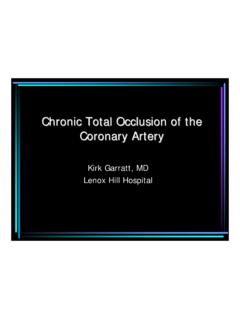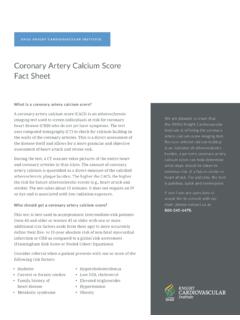Transcription of Coronary Artery Disease: Pathogenesis, Progression of ...
1 Lamiaa Mageed*Department of Biochemistry, Egypt*Corresponding author: Lamiaa Mageed, Department of Biochemistry, National Research Center, Giza, EgyptSubmission: July 20, 2018; Published: November 15, 2018 Coronary Artery disease : Pathogenesis, Progression of Atherosclerosis and Risk FactorsIntroductionCoronary Artery diseaseCoronary Artery diseases (CAD) known as atherosclerotic heart disease , atherosclerotic cardiovascular disease , Coronary heart disease (CHD), or ischemic heart disease (IHD) [1]. CAD is the largest contributor of cardiovascular diseases (CVDs) and mortality rate is due in prevalence to atherosclerosis, a chronic inflammatory condition of the arterial wall. Unfortunately, myocardial infarction (MI) is still a first common manifestation of CHD and, in about 50% of patients; angina pectoris is the first symptom of the pathology [2].Mini Review1/7 Copyright All rights are reserved by Lamiaa 2 - Issue - 4 Open Journal of Cardiology & Heart Diseases CCRIMSON PUBLISHERSW ings to the ResearchISSN 2578-0204 AtherosclerosisFigure 1: Atherosclerotic lesion in a human is derived from the Greek words athera meaning soft gruel-like (porridge-/mush-/paste-like) fatty deposit and sclerosis which means hardening.
2 Atherosclerosis is a pathological process that affects large- and medium-sized arteries and causes Coronary Artery disease (angina pectoris and myocardial infarction), cerebrovascular disease (ischemic stroke and vascular dementia) and peripheral vascular disease (intermittent claudication and gangrene) [3]. Atherosclerosis is a chronic cumulative disease progressing over years. It is characterized by atherosclerotic plaques formed in the wall of the vessels, consisting of necrotic cores, calcified regions, accumulated modified lipids, and inflamed smooth muscle cells (SMCs), endothelial cells, leukocytes, and foam cells (Figure 1). Lesions begin early as fatty streaks and progress into pathologic lesions under the influence of both genetic and lifestyle insults [4,5]. Panel A shows a cross-sectioned Coronary Artery from a patient who died of a massive myocardial infarction.
3 It contains an occlusive thrombus superimposed on a lipid-rich atherosclerotic plaque. The fibrous cap covering the lipid-rich core has ruptured (area between the arrows), exposing the thrombogenic core to the blood. Trichrome stain was used, rendering luminal thrombus and intra-plaque hemorrhage red and collagen blue. Panel B is a high-power micrograph of the area in Panel A indicated by the asterisk and Open J Cardiol Heart Dis Copyright Lamiaa Mageed2/7 How to cite this article: Lamiaa Mageed. Coronary Artery disease : Pathogenesis, Progression of Atherosclerosis and Risk Factors. Open J Cardiol Heart Dis. 2(4). : 2 - Issue - 4shows that the contents of the atheromatous plaque have seeped through the gap in the cap into the lumen, suggesting that plaque rupture preceded thrombosis (the asterisk indicates cholesterol crystals). (Panels A and B courtesy of Dr.)
4 Erling Falk, University of Aarhus, Aarhus, Denmark.)Panel C illustrates the consequences of the activation of immune cells in a Coronary plaque. Microbes, autoantigens, and various inflammatory molecules can activate cells, macrophages, and mast cells, leading to the secretion of inflammatory cytokines ( , interferon- and tumor necrosis factor) that reduce the stability of plaque. The activation of macrophages and mast cells also causes the release of metalloproteinases and cysteine proteases, which directly attack collagen and other components of the tissue matrix. These cells may also produce pro-thrombotic and pro-coagulant factors that directly precipitate the formation of thrombus at the site of plaque of atherosclerosisThe pathologist Felix Marchand first introduced the term atherosclerosis in 1904, describing the association of fatty degeneration and vessel stiffening [6].
5 This process affects medium and large-sized arteries and is characterized by patchy intramural thickening of the sub-intima that encroaches on the arterial lumen. Each vascular bed may be affected by this process; the etiology, treatment and clinical impact of atherosclerosis varies from one vascular bed to another [7]. The earliest visible lesion of atherosclerosis is the fatty streak, which is due to an accumulation of lipid-laden foam cells in the intimal layer of the Artery (Figure 2). With time; the fatty streak evolves into a fibrous plaque, the hallmark of established atherosclerosis. Ultimately the lesion may evolve to contain large amounts of lipid; if it becomes unstable, denudation of overlying endothelium, or plaque rupture, may result in thrombotic occlusion of the overlying Artery [7,8].Figure 2: Normal heart, normal Artery and Artery with 3: Atherosclerotic plaque lesions (atheromata) are composed of three major components.
6 The first is the cellular component comprised predominately of smooth muscle cells and macrophages. The second component is the connective tissue matrix and extracellular lipid. The third component is intracellular lipid that accumulates within macrophages, thereby converting them into foam cells (Figure 3). Atherosclerotic lesions develop as are sult of inflammatory stimuli, subsequent release of various cytokines, proliferation of smooth muscle cells, synthesis of connective tissue matrix, and accumulation of macrophages and lipid [9,10].3/7 How to cite this article: Lamiaa Mageed. Coronary Artery disease : Pathogenesis, Progression of Atherosclerosis and Risk Factors. Open J Cardiol Heart Dis. 2(4). : J Cardiol Heart DisCopyright Lamiaa MageedVolume 2 - Issue - 4 There are 2 major types of vascular pathology leading to stroke, stroke subtypes and IHD. One is atherosclerosis, a large vascular pathology typically observed in the aorta, Coronary arteries, carotid arteries and basal cerebral arteries, and characterized by lipid accumulation with proliferative changes leading to plaque formation [11].
7 The other pathology is arteriolosclerosis, a small vascular pathology typically occurring in small penetrating arterioles in the basal ganglions of the brain, characterized by necrosis or apoptosis of smooth muscle cells within the media, leading to the formation of micro-aneurysms (intra-parenchymal hemorrhage) and fibrous proliferative changes (lacunars stroke) (Figure 4) [11].Figure 4: Two types of vascular pathology in large and small arteries: Atherosclerosis (Left) and Arteriosclerosis (Right). Progression of atherosclerosis Excess generation of (ROS) represents an important pathological process in atherogenesis. Each component of the atherosclerotic blood vessel has been demonstrated to increase production of ROS, primarily superoxide anion (O2-) [12]. Important sources of ROS are vascular smooth muscle cells, endothelial cells, fibroblasts, and infiltrating leukocytes [13].
8 Production of ROS affects gene transcription, damages DNA, and increases production of inflammatory transcription factors [14]. The two best-characterized effects include oxidation of LDL and scavenging of endothelium-derived NO . The Progression of atherosclerotic disease has been described as moving from an early lesion (phase1) to a more advanced fibro-lipid lesion (phase 2) (Figure 5). The formation of thrombus or hematoma can advance into an acute phase (phase 3 and 4) or even to total occlusion (phase 5). Although there is substantial evidence for this process in the Coronary circulation, it is highly likely that it also occurs in peripheral Artery disease (PAD). Magnetic resonance imaging (MRI) has allowed better characterization of lesions and has shown the importance of plaque composition to subsequent clinical events [15,16].Figure 5: Phases of lesion J Cardiol Heart Dis Copyright Lamiaa Mageed4/7 How to cite this article: Lamiaa Mageed.
9 Coronary Artery disease : Pathogenesis, Progression of Atherosclerosis and Risk Factors. Open J Cardiol Heart Dis. 2(4). : 2 - Issue - 4 Risk Factors Influencing Coronary Artery DiseaseA risk factor can be defined as a characteristic that is associated with increased or decreased likelihood of subsequent development of CVD [17]. Types of risk factorsNon-modifiable risk factors: Risk factors that cannot be prevented, changed or controlled such as: age and gender, because they are not modifiable, they are less determining in terms of risk factor management [17].A. AgeAgeing is an un-modifiable risk factor for CAD, with males clinically manifesting this condition at 50-65 years of age and females about 10 years later, following menopause. The WHO reports that the principal cause of death of people over 65 years is CAD, and as age increases, a substantial proportion of deaths are among females [18].
10 In many developed countries, the number and proportion of older people (over 65 years) is increasing, which is largely explained by declines in fertility and mortality. The ageing population of many countries has accelerated the contribution of CAD to total disease burden. It is predicted that the global ageing population will maintain CAD as a predominant cause of death worldwide [18]. Among countries with high but declining CAD mortality, it is suggested that these trends are changing with respect to younger age subgroups [19]. B. GenderCoronary Artery disease is the leading cause of mortality for both adult males and females alike worldwide. Although the initial manifestation of CAD is delayed in females by about ten years compared to males, there is not an abrupt increase in CAD mortality rates for females immediately following menopause but a progressive increase over subsequent years [20,21].
